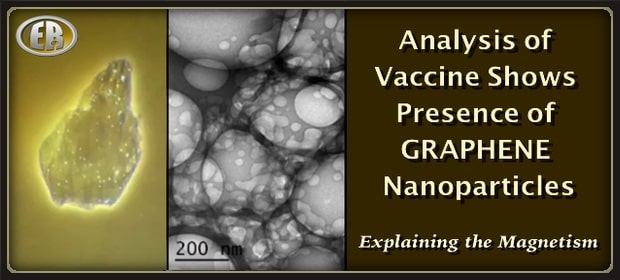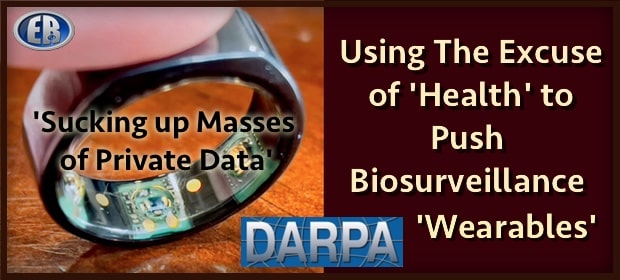
ER Editor: Yesterday, we published a piece which shows preliminary microscopic analysis of one of the Covid vaccines. Graphene was present. See Analysis of Vaccination Vial Confirms Presence of Graphene Nanoparticles [VIDEO].

We claim no scientific expertise at ER, but what we can see from the EU Commission Cordis promotional article below is the explicit use of graphene in ‘quantum dot detectors’ for surveilling the health of the wearer. Wearables are the next thing in terms of health surveillance – OUR health surveillance. And a key component to these devices is graphene, as the piece below explains.
So why wouldn’t graphene be found in those vaccines?
For more on the sinister, military-security aspect of these ‘wearables’, see this piece by Whitney Webb, run by Technocracy News: Trifecta: DARPA, IARPA And Now HARPA To Complete ‘Digital Dictatorship’.

********
Graphene quantum dot detectors for next-generation health monitoring wearables
********
Health monitoring, especially during exercise, was one of the very first applications allowing smart wearables to graduate from an appealing technological concept to actual, marketable products. However, extended health monitoring to detect all kinds of health markers quickly tends to become bulky. This means that, until now, engineers have had to find the best compromise between functionality and comfort: only a limited number of components could be integrated, making the whole system much less appealing than it could be.
 A solution, according Dr Frank Koppens from the Spanish Institute of Photonic Sciences (ICFO), lies in the inherent properties of graphene quantum dot (GQD) detectors – photodetectors with characteristics derived from graphene and semi-conducting quantum dots. GQD detectors would indeed enable the development of a flexible, compact and wearable system for constant monitoring of consumer health and muscle health of athletes during exercise or after injury.
A solution, according Dr Frank Koppens from the Spanish Institute of Photonic Sciences (ICFO), lies in the inherent properties of graphene quantum dot (GQD) detectors – photodetectors with characteristics derived from graphene and semi-conducting quantum dots. GQD detectors would indeed enable the development of a flexible, compact and wearable system for constant monitoring of consumer health and muscle health of athletes during exercise or after injury.
“Our photodetector is very sensitive to light for a very broad wavelength range, from 300 to 2,200 nm. And most importantly, it is flexible,” stresses Dr Koppens. “This is made possible by the fact that the detector can be placed on basically any flexible substrate. It’s just a few hundred nanometres thick, so it’s excellent for integration into wearable sensors.”
The use of graphene is key here, as it provides for an ultra-thin conductor with extremely high conductivity properties, notably electronic mobility. Furthermore, graphene can easily be transferred to flexible substrates and can cover relatively large areas.
“It works as follows,” Dr Koppens explains. “Light, be it from a LED device or from the environment, enters the skin, after which it interacts with the tissue and blood vessels. There, it is partially absorbed, but also partially bounces off the skin, in which case it can be picked up by the detector. Now, if the blood veins expand and contract due to heartbeat, the photodetection signal will modulate as well. In other words, the heartbeat is directly visible from the photodetection signal.”
This, of course, is just an example. The technology, which was developed under the GRAPHEALTH (Hybrid quantum dot and graphene wearable sensor for systemic haemodynamics and hydration monitoring) project, has demonstrated its capacity to be used for the likes of oxygen monitoring as well. Other important health markers will also soon be detectable. The GRAPHEALTH photodetector is compatible with current flexible electronic manufacturing processes, which means industry should not expect major investment costs.
“We have made several prototype wearable devices – including one for the wrist and a patch that is more like a thin sticker – and we have shown that these can be produced with scalable large-area graphene,” enthuses Dr Koppens.
Now that the project has come to an end, Dr Koppens and his team intend to make the GRAPHEALTH system more versatile by integrating more health markers. They also want to develop a completely integrated health patch, which would include not only the patch itself but also the electronics, wireless power transfer and wireless data transfer.
“It’s difficult to make any predictions regarding potential commercialisation, as flexible electronics and wearables are very young markets. We can create a very large range of different wearables, and integration into existing wearables, such as combining with a smart watch, can also be considered. The challenge now is to make wise choices on which application to focus exactly,” Dr Koppens concludes.
************
Source

••••
The Liberty Beacon Project is now expanding at a near exponential rate, and for this we are grateful and excited! But we must also be practical. For 7 years we have not asked for any donations, and have built this project with our own funds as we grew. We are now experiencing ever increasing growing pains due to the large number of websites and projects we represent. So we have just installed donation buttons on our websites and ask that you consider this when you visit them. Nothing is too small. We thank you for all your support and your considerations … (TLB)
••••
Comment Policy: As a privately owned web site, we reserve the right to remove comments that contain spam, advertising, vulgarity, threats of violence, racism, or personal/abusive attacks on other users. This also applies to trolling, the use of more than one alias, or just intentional mischief. Enforcement of this policy is at the discretion of this websites administrators. Repeat offenders may be blocked or permanently banned without prior warning.
••••
Disclaimer: TLB websites contain copyrighted material the use of which has not always been specifically authorized by the copyright owner. We are making such material available to our readers under the provisions of “fair use” in an effort to advance a better understanding of political, health, economic and social issues. The material on this site is distributed without profit to those who have expressed a prior interest in receiving it for research and educational purposes. If you wish to use copyrighted material for purposes other than “fair use” you must request permission from the copyright owner.
••••
Disclaimer: The information and opinions shared are for informational purposes only including, but not limited to, text, graphics, images and other material are not intended as medical advice or instruction. Nothing mentioned is intended to be a substitute for professional medical advice, diagnosis or treatment.

